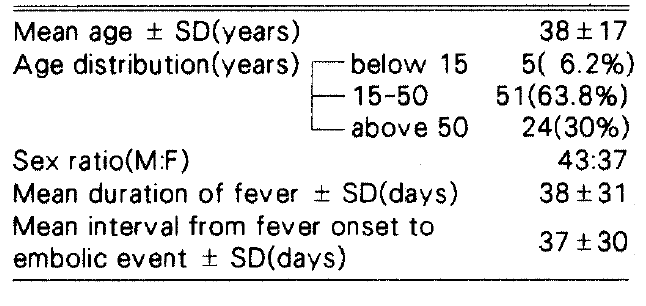1. Hyon MS, Kang DH, Koh KK, Sohn DW, Oh BH, Lee MM, Park YB, Choi YS, Seo JD, Lee YW. Clinical Observation of Infective Endocarditis. Kor J Intern Med 37(5):609. 1989.
2. Steckelberg JM, Murphy JG, Ballard D, Bailey K, Tajik AJ, Giuliani ER, Wilson WR. Emboli in Infective Endocarditis: The prognostic Value of Echocardiography. Ann Intern Med 114:635. 1991.


3. Stewart JA, Silimperi D, Harris P, Wise NK, Franker TD Jr, Kisslo JA. Echocardiographic documentation of vegetative lesions in infective endocarditis: clinical implication. Circulation 61:374. 1980.


4. Egeblad H, Wennevold A, Berning J, Lauridsen P. Mitral valve replacement in infective endocarditis as prophylaxis against embolism. Identification of patients at risk by 2-dimentional echocardiography. Eur J Cardiol 10:369. 1979.

5. Davis RS, Strom JA, Frishman W. The demonstaration of vegetation by echocardiography in bacterial endocarditis. An indication for early surgical intervention. Am J Med 69:57. 1980.


6. Stulz P, Pfisterer M, Jenzer HR, Hasse J, Gradel E. Emergency valve replacement for active infective endocarditis. J Cardivasc Surg 30:20. 1989.
7. McKinsey DS, Ratts TE, Bisno AL. Underlying cardiac lesions in adults with infective endocarditis: the challenging spectrum. Am J Med 82:681. 1987.


8. Sanabria TJ, Alpert JS, Goldberg R, Pape LA, Cheeseman SH. Increasing Freuqency of Staphylococcal Infective Endocarditis: Experience at a University Hospital, 1981 through 1988. Arch Intern Med 150:1305. 1990.


9. Nagger CZ, Forgacs P. Infective endocarditis-a challenging disease. Med Clin Morth Am 70:1279. 1986.

10. Garvery GJ, Neu HC. Infective endocarditis-and evolving disease: A review of endocarditis at the Columbia-Presbyterian Medical Center, 1968ŌĆō1973. Medicine 57:105. 1978.


11. Kaye D. Changing pattern of infective endocarditis. Am J Med 78:157. 1985.


12. Gordis L. The virtual disappearance of rheumatic fever in the United States: Lessons in the rise and fall of disease. Circulation 72:1155. 1985.


13. Choudhury R, Grover A, Varma J, bidwai PS, Sapru RP. Active Infctive Endocarditis Observed in an Indian Hospital 1981ŌĆō1991. Am J Cardiol 70:1453. 1992.


14. Cheng JJ, Chang SC, Lien WP, Tseng YZ, Lee YT, Hsieh YY, Wu MC. Retrospective Analysis of 97 Patients with Infective Endocarditis Seen Over the Past 8 Years. J Formosan Med Assoc 88:213. 1989.
15. Mintz GS, Kotler MN, Segal BL, Parry WR. Comparison of two dimentional and M-mode echocardiography in the evaluation of patients with endocarditis. Am J Cardiol 43:738. 1979.


16. Lutas EM, Roberts RB, Devereux RB, Prieto LM. Relation between the presence of echocardiographic vegetations and the complication rate in infective endocarditis. Am Heart J 112:107. 1989.

17. Buda AJ, Zotz RJ, LeMire , Bach DS. Prognostic significance of vegetations detected by two-dimentional echocardiography in infective endocarditis. Am Heart J 112:1291. 1986.


18. Jaffe WM, Morgan DE, Pearlman AS, Otto CM. Infective endocarditis, 1983ŌĆō1988: Echocardiographic Findings and Factors Influencing Morbidity and Mortality. J Am Coll Cardiol 15:1227. 1990.


19. Mugge A, Daniel WG, Frank G, Lichtlen PR. Echocardiography in Infective Endocarditis: Reassessment of prognostic implications of vegetation size determined by the trasthoracic and the transesophagedal approach. J Am Coll Cardiol 14:631. 1989.


20. Wong D, Chandraratna NA, Wishnow RM, Disitnanond V. Clinical implication of large vegetation in infective endocarditis. Arch Intern Med 143:1874. 1983.


21. Jung JY, Saab SB, Almond CH. The case for early surgical treatment of left sided primary infective endocarditis. A collective review. J Thorac Cardiovasc Surg 70:509. 1975.


22. Richardson JV, Karp RB, Kirklin JW, Dismukes WE. Treatment of infective endocardits. 10 year comparative analysis. Circulation 58:589. 1978.


24. Brandenberg RO, Giuliani ER, Wilson WR. Infective Endocarditis:A 25 years overview of diagnosis and therapy. J Am Coll Cardiol 1:280. 1983.


25. Park SH, Yang JM, Jeong HR, Lee MY, Seung KB, Chae JS, Choi KB. A Case of Infective Endocarditis Caused by Bacillus Species. Kor J Intern Med 38(1):131. 1990.
26. Schulant RC, Alexander RW. HurstŌĆÖs the heart: Arteries and veins. 8th. 1694. New York: McGrraw-Hill, 1994.
27. Wyngaarden JB, Smith LH, Bennett JC. Cecil textbook of medicine. 19th. 1641. Philadelphia: WB Saunders Co., 1992.
28. Mandell GL, Douglas RG, Bennett JE. Principles and Practice of Infectious Diseases. 3rd. 1495. New York: Churchill Livingstone, 1990.




 PDF Links
PDF Links PubReader
PubReader ePub Link
ePub Link Full text via DOI
Full text via DOI Download Citation
Download Citation Print
Print





